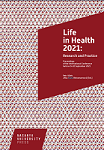Application of the brief intervention method in prevention of HIV/AIDS spread - 6 years of project implementation
Application of the brief intervention method in prevention of HIV/AIDS spread - 6 years of project implementation
Author(s): Lidmila Hamplová, Soňa Jexová, Veronika Pišová, Petr Hulinský
Subject(s): Education, Health and medicine and law, Sociology of Education
Published by: Masarykova univerzita nakladatelství
Keywords: brief intervention; education; intervention; HIV/AIDS prevention; health literacy;
Summary/Abstract: The National Programme for Addressing HIV/AIDS in the Czech Republic 2018- 2022 is a strategic document for combating the spread of HIV/AIDS and other sexually transmitted infections in the Czech Republic. The activities of the programme are funded by the Czech Republic’s Ministry of Health’s subsidy programmed called the National Programme on HIV AIDS. The target population groups of the programme are not only persons at high risk of HIV/AIDS infection due to risky sexual behaviour, but also adolescents, teenagers, and other persons of reproductive age with a lower level of health literacy. One possibility that could increase their level of knowledge is the short intervention method, which is also applicable in the field of prevention of sexually transmitted diseases. The aim and purpose of the brief intervention method recommended by the WHO is to increase the health literacy of the intervened persons, eliminate their risky behaviour and promote their reproductive health. Reducing the incidence of HIV-positive persons in the population brings significant financial savings in terms of reduced treatment costs for both HIV-positive patients and especially those with advanced AIDS. The application of the brief intervention method in the field of prevention of HIV/AIDS and other STIs was the essence of the 6-year project conducted by the University of Health Sciences in health care facilities across the Czech Republic. Patients were privately familiarised with the content of educational cards and were offered the opportunity for a closer consultation on the topic. After the education, the effectiveness of the intervention was evaluated by a short questionnaire. 5,146 people of reproductive age were intervened in more than 150 health care facilities across the country during the implementation of the 6-year project. A total of 1,347 patients (26%) reported that their loved ones were not adequately protected from HIV/AIDS and other STIs. Only 56% of the male and 66% of the female respondents reported that they had ever spoken to their loved ones about STI prevention. After the education, 56% of the reproductive-age interveners requested copies of the education cards for their loved ones. Increased health literacy due to education was more often acknowledged by women than men, and especially by those in the 15–25 age group, where 74% of those in this age group who intervened confirmed increased health literacy. Women (75%) were more likely than men to believe that their loved ones were not adequately protecting themselves from STIs. Patients with lower levels of education were more likely to admit an increase in health literacy than those with university education (64%). 71% of patients with only primary education, completed at fifteen years old in the Czech Republic, said their health literacy had increased. 70% or patients who finished their schooling after secondary education, completed at eighteen years old in the Czech Republic, said their health literacy had increased. Over the course of 6 years, more than 5,000 people of reproductive age were educated in the project. The health care environment in which the interventions were implemented contributed significantly to the success of the brief intervention method. The realisation of the project by the College of Health contributed to the implementation of the National Programme for Addressing HIV/AIDS in the Czech Republic 2018–2022 and at the same time the National Action Plan, entitled Development of Health Literacy.
Book: Life in Health 2021: Research and Practice
- Page Range: 89-95
- Page Count: 7
- Publication Year: 2021
- Language: English
- Content File-PDF

